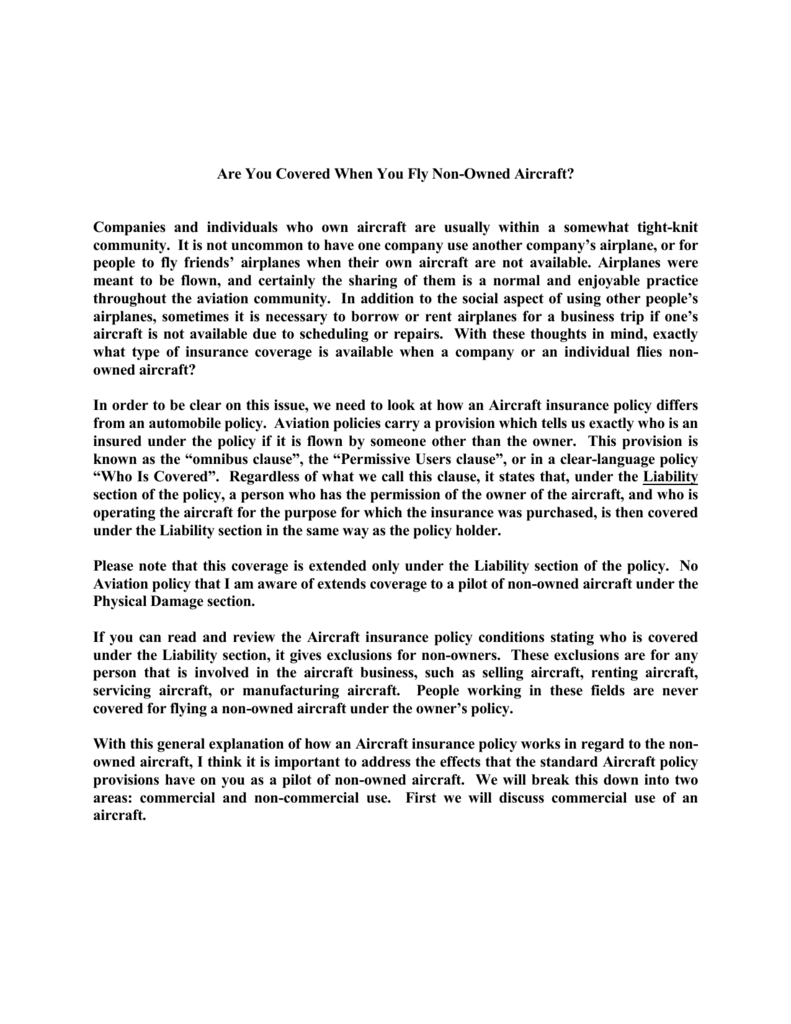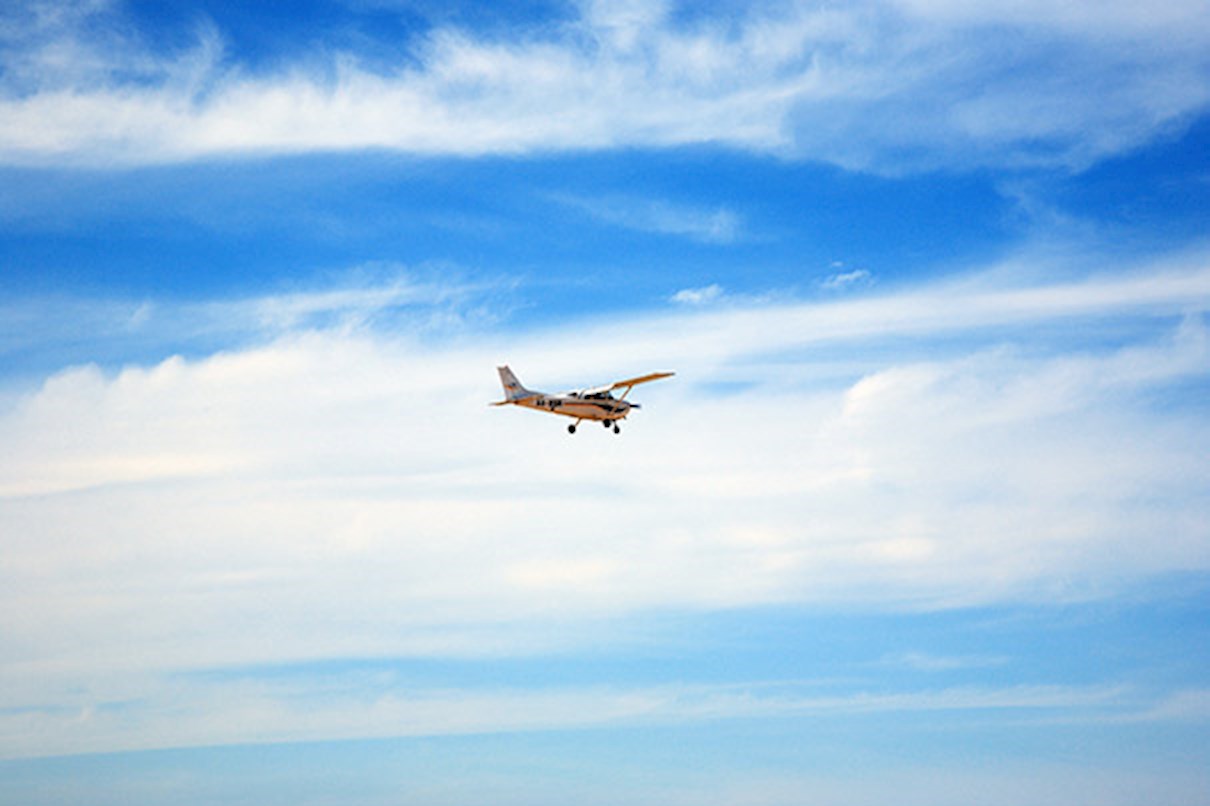Non Owned Aircraft Insurance - Once an underwriter has a clear picture of the exposure, he will offer a quotation—usually with requirements attached such as evidence of underlying insurance, recurrent training, or some other underwriting prerequisite. Requests for liability limits can vary from a low of $5,000,000 to $100,000,000 or more depending on the exposure.
In order to protect the corporation when it charters an aircraft on company business, it is recommended the corporation request additional insured status under the charter company's insurance policy and require the charter company's policy to be primary without right of contribution from any coverage the corporation may carry.
Non Owned Aircraft Insurance

Evidence of this coverage should be requested in the form of a Certificate of Insurance and a copy of the related endorsement. The charter company's policy would therefore, protect the corporation up to the limits of liability of the charter company's policy;
Ready For Takeoff? Having Sufficient Insured Value Is Critical
the corporation's non-owned aircraft liability insurance policy would then apply as excess coverage. In this regard, if the charter company's policy has sufficient limits, the corporation's policy would not be affected. Planning for the team's future is one of a leader's most important responsibilities.
A solid plan makes it easier to navigate today's uncertain world and when priorities change or a crisis happens, a well-crafted plan will help keep the team on track. The 2024 NBAA Maintenance Conference provides vital education and networking opportunities for anyone involved in business aircraft maintenance – from technicians to directors of maintenance.
Stay up-to-date on the latest operational information critical to your job and connect with over 900 fellow peers. The setting is common in our business environment. An important meeting requires senior executives to charter a corporate aircraft because the corporation's own airplane is unavailable or the corporation simply doesn't own one.

A call is placed to the local aircraft charter company to make arrangements for the flight. This trip will facilitate the timeliness of the meeting and give the corporation an edge on its competition. Unfortunately, something goes terribly wrong and there's an accident.
Protecting You And Your Family From Financial Loss
Although the charter company had added the corporation as an additional insured under its liability policy, it becomes disturbingly clear the charter company's coverage limits will be inadequate to cover the resulting flood of lawsuits. The claimants are now directing their legal recourse against the corporation.
Why you ask? The existence of the flight originated from your meeting. Unfortunately for some, this is where the need for non-owned aircraft liability insurance makes itself known. Whether you are a pilot training at a flight school, renting from an FBO, or anyone who operates an aircraft you don't own, having a non-owned aircraft insurance policy can protect you from the potentially catastrophic financial consequences of an aircraft accident.
You've completed your pre-flight check and are getting ready to take off. But have you thought of everything? Whether your aircraft is brand new or you've owned it for many years, have you verified that you would be fully covered in the event of a loss?
Medical Payments are included in the amount of $1,000 to cover payments for medical bills and funeral expenses of an occupant of the aircraft. Options up to $10,000 are available. In addition to Medical Payments, your Bodily Injury coverage will help protect you in the event of a claim.

Aviation Loss Payments Clear Title Clear Skies
The liability associated with renting an aircraft can have wide-ranging effects. Ensuring that you have adequate non-owned aircraft insurance allows you to pursue your passion for flight with confidence that an unfortunate incident won't result in a financial crisis.
The key is to give yourself plenty of time to research your options so that you can make a well-informed purchase decision and have insurance in place before you ever take a flight in an aircraft you do not own.
The 2024 NBAA Maintenance Conference provides vital education and networking opportunities for anyone involved in business aircraft maintenance – from technicians to directors of maintenance. Stay up-to-date on the latest operational information critical to your job and connect with over 900 fellow peers.
Most aircraft insurance policies are designed to protect the owner of the aircraft. Flight school policies are generally designed to protect the flight school. Even if the policy lists you as a pilot, the insurance company could pay a claim for the owner and then sue you to recover their losses.
Our Company Video
Let's imagine that, unfortunately, you experienced a loss, incident or accident during which your insured aircraft sustained physical damage. Whether it results in a “total loss” or a “partial loss,” it is commonplace that after the adjustment and settlement of the physical damage insurance claim, the aviation insurance provider's claim handler prepares to tender its payment of the physical damage loss to the

policyholder (the “named insured”) and any additional loss payee(s) endorsed under the aviation insurance policy, unless otherwise directed. Whether it's jetting across continents or soaring beyond the stratosphere, Starr Aviation's team of experts understands the industry's constantly changing risk environment, and develops customized property & casualty insurance plans that catalyze the success of organizations and their people.
If you're interested in elevating your career to the next level, look no further than SDC2025. You'll learn current best practices and trends from industry experts and fellow attendees through top-level education sessions and critical peer-to-peer networking to help you work smarter, not harder in the year ahead.
Aircraft Physical Damage (PD), including loss of use for the owner, will cover damage to the aircraft caused by the insured. It is recommended that the amount of Aircraft Physical Damage equals the cost of the most expensive aircraft you rent or borrow.
You could be liable for the total amount of damage to the aircraft, not just the deductible. The insurance company will pay the flight school for the repair and could then subrogate against you, the pilot.
Founded in 1947 and based in Washington, DC, the National Business Aviation Association (NBAA) is the leading organization for companies that rely on general aviation aircraft to help make their businesses more efficient, productive and successful.

Aircraft Liability Insurance protects you against claims arising from Bodily Injury (BI) and Property Damage (PD). When your passenger is injured or you damage property not owned by you, your Liability Insurance will protect you on a per occurrence (OCC) basis.
You've rented or borrowed an aircraft and an incident has resulted in damage to the aircraft itself, bodily injury to another person or damage to the property of others. Did you know that the aircraft owner's policy may not provide coverage to protect you, or if coverage is provided, it may be insufficient to cover your financial costs?
Many pilots aren't aware of this fact, and some end up with tremendous out-of-pocket payments to resolve their legal liabilities. The 2023 NBAA Business Aviation Convention & Exhibition (NBAA-BACE) will return to Las Vegas, NV from October 17-19.
Save the date and make plans to attend the biggest and most productive event of the year for business aviation. Travers & Associates is proud to provide a wide range of aviation insurance products and services.
We offer coverage ranging from aircraft liability insurance and aviation hull insurance designed to give you peace of mind to airplane renter insurance to cover an aircraft you may rent or borrow. Non-Owned Aircraft Liability insurance provides coverage in the event a corporation becomes legally liable for bodily injury (including passengers) and property damage to third parties as a result of a loss involving a corporation's or employee's use of a non-owned aircraft.

Liability coverage would be provided to the corporation as long as the aircraft is not partly or wholly owned or registered in the name of the corporation, its subsidiaries, etc. An employee who operates a non-owned aircraft on company business would be provided the same coverage as the corporation as long as the aircraft is not owned in full or part by, or registered in the name of such person or any member of his household.
An employee who operates his owned aircraft on company business must rely on his insurance policy to properly provide insurance for himself. Similarly, when an employee uses owned or non-owned aircraft on company business, it is recommended that the corporation request additional insured status under the employee's policy or the employee's FBO policy if renting aircraft.
Again, the employee's policy or FBO policy liability limit will act as a first line of defense for the corporation before triggering the corporation's non-owned aircraft coverage. Although the limits of liability carried by the employee on a personal aircraft or FBO policy will be significantly lower than a charter company, it is good operating practice to establish such requirements.
If you're interested in elevating your career to the next level, look no further than SDC2025. You'll learn current best practices and trends from industry experts and fellow attendees through top-level education sessions and critical peer-to-peer networking to help you work smarter, not harder in the year ahead.
non owned aircraft liability insurance, small private aircraft insurance companies, aopa non owned aircraft insurance, private aircraft insurance, aircraft insurance quotes, aopa non owners insurance, non owned aircraft renters insurance, cheap aircraft insurance